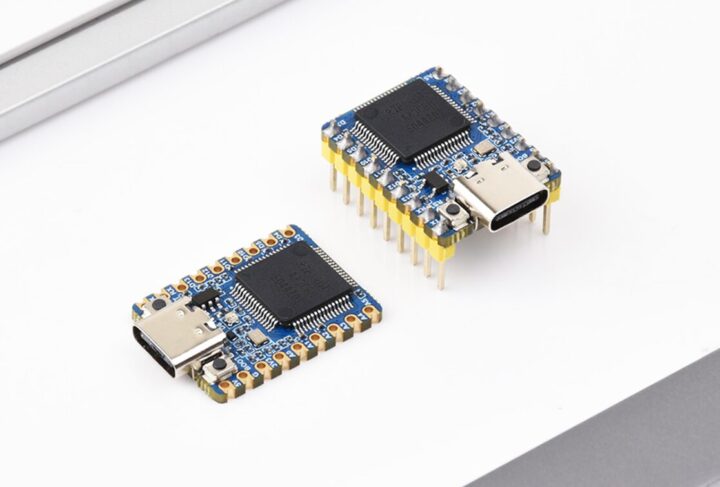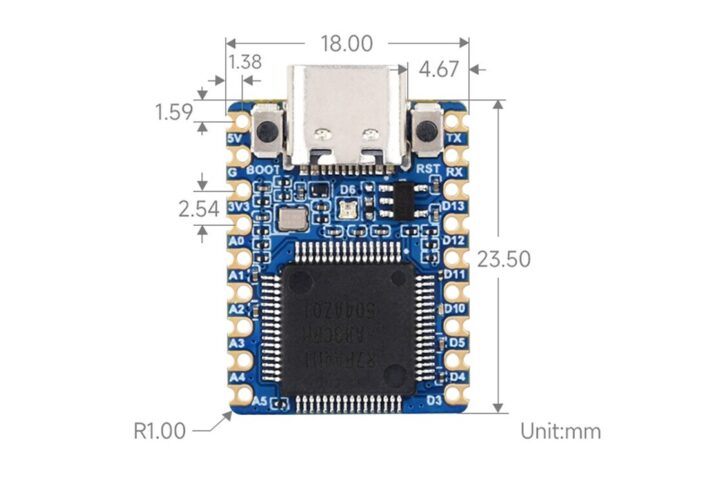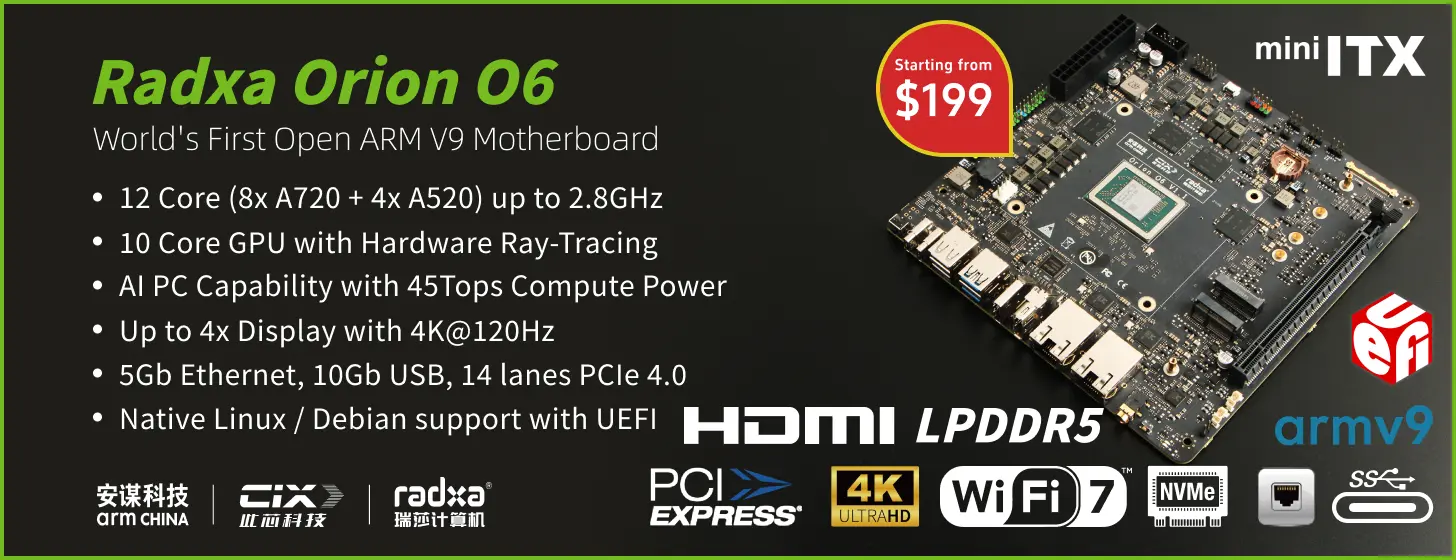Waveshare RA4M1-Zero is a mini development board built around the Renesas RA4M1 32-bit Arm Cortex-M4 MCU running at 48MHz. The MCU also features 256KB of flash memory, 32KB of SRAM, 8KB of EEPROM, and a built-in Floating Point Unit (FPU).
Hardware peripherals include a 14-bit ADC, a 12-bit DAC, a CAN bus controller, an onboard USB 2.0 interface, and WS2812 RGB LED. The MCU also supports firmware encryption, secure boot, and tamper-proof security features to ensure application safety. Its small size (23.5 x 18mm) and castellated module design make it suitable for space-constrained applications, including IoT devices, industrial control systems, secure embedded systems, and compact sensor nodes.
RA4M1-Zero mini development board specifications:
- MCU – Renesas RA4M1 (R7FA4M1AB3CFM) as found in the Arduino UNO R4
- CPU 32-bit Arm Cortex-M4F @ 48MHz
- Memory – 32KB SRAM
- Storage – 256KB Flash, 8KB EEPROM
- USB – USB 2.0 device interface via USB Type-C connector
- Expansion I/Os
- 2x 9-pin 2.54mm pitch headers and castellated holes with
- Up to 13x GPIO
- 1x SPI, 1x UART, 1x I2C
- 1x CAN Bus
- Up to 6x 14-bit analog inputs
- 1x 12-bit DAC (on A0 Pin)
- 5V, 3.3V, and GND
- 10x solder pads with
- Up to 8x GPIO/Digital
- 1x UART, 1x I2C
- 3x 14-bit ADC
- 1x CAN Bus (TBC)
- 2x 9-pin 2.54mm pitch headers and castellated holes with
- Security – AES128/256, secure boot, hardware encryption, key storage
- Debugging – SMD solder pads
- Power
- ME6217C33M5G LDO regulator, 3.3V output, up to 800mA
- Selectable MCU voltage (3.3V default, 5V via 0R resistor)
- Dimensions – 23.5 x 18mm
The RA4M1-Zero works with the Arduino IDE, making it easy for developers to get started. All you need to do is install the RA4M1-Zero board files in your Arduino IDE, and you can upload your code with the Arduino IDE. For flashing firmware, there’s a Renesas flashing tool to install it. You need to hold BOOT and hit RESET to enter bootloader mode, pick the right COM port, load your firmware, and flash it. The company also provides a bootloader firmware in case you brick your MCU. Examples for UART and CAN (read/write) are available, but you’ll need an external CAN transceiver to test CAN-related codes. All other documentation, including schematics, firmware, flashing tool, and datasheets, can be found on the wiki.
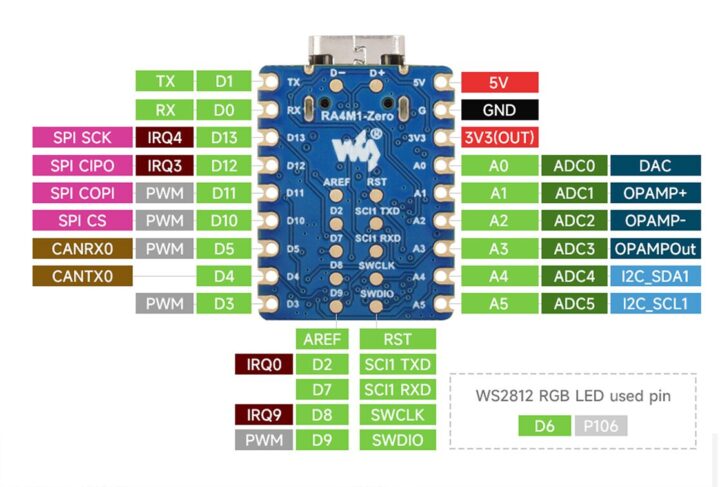
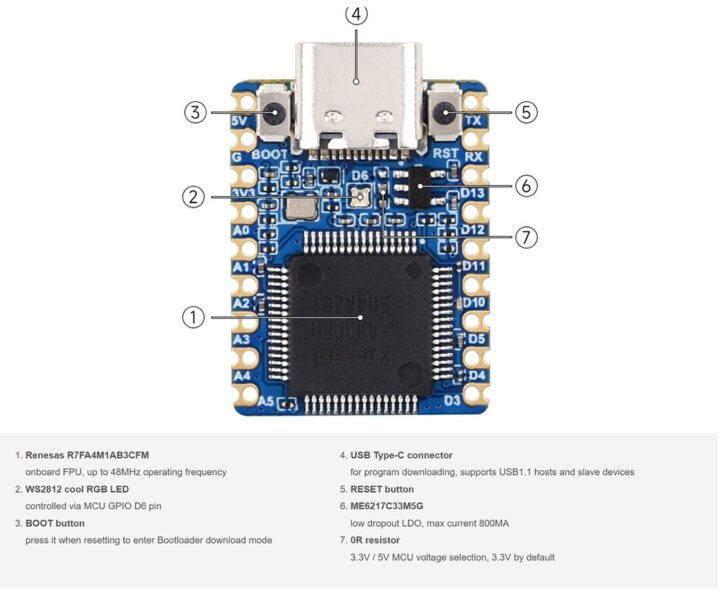
Previously, we have written about other development boards based on the RA4M1 MCU, which include the Maker Go RA4M1-R4 development board and the Seeed Studio XIAO RA4M1 development board. Both are compact and are designed for space-constrained applications.
The Waveshare RA4M1-Zero development boards come in two variants, the RA4M1-Zero (without header) and RA4M1-Zero-M (with pre-soldered header). Both variants are available on AliExpress for $8.99 and $9.89, respectively, and on Amazon for $13.99 and $14.99. Alternatively, you’ll also find the board on Waveshare’s official store priced at $6.49 and up before shipping.
Debashis Das is a technical content writer and embedded engineer with over five years of experience in the industry. With expertise in Embedded C, PCB Design, and SEO optimization, he effectively blends difficult technical topics with clear communication
Support CNX Software! Donate via cryptocurrencies, become a Patron on Patreon, or purchase goods on Amazon or Aliexpress. We also use affiliate links in articles to earn commissions if you make a purchase after clicking on those links.


